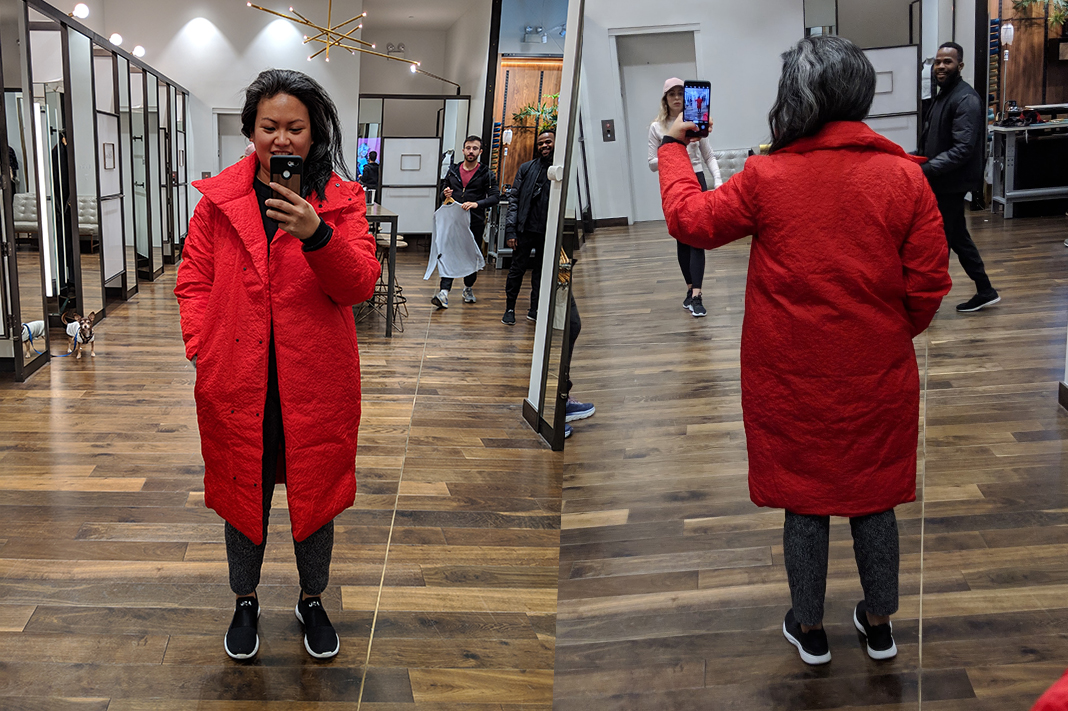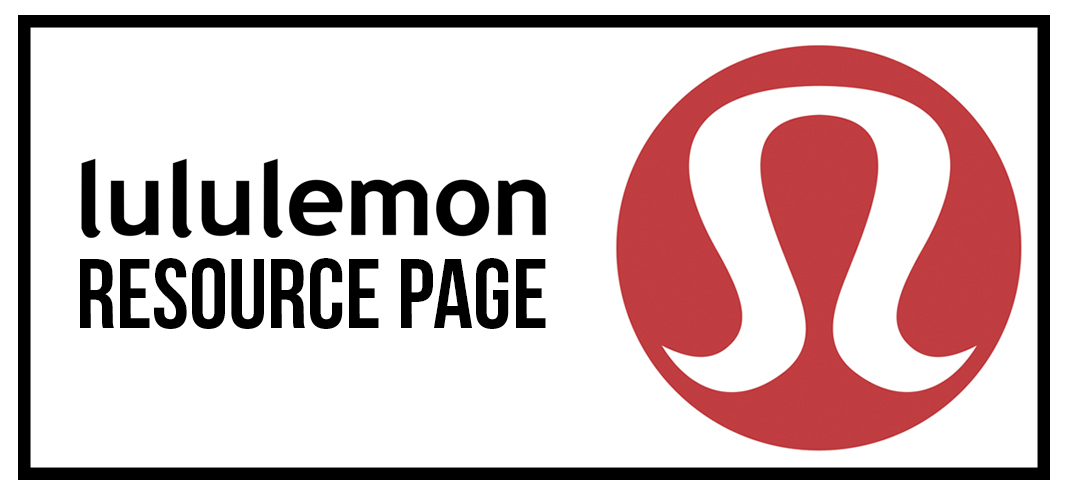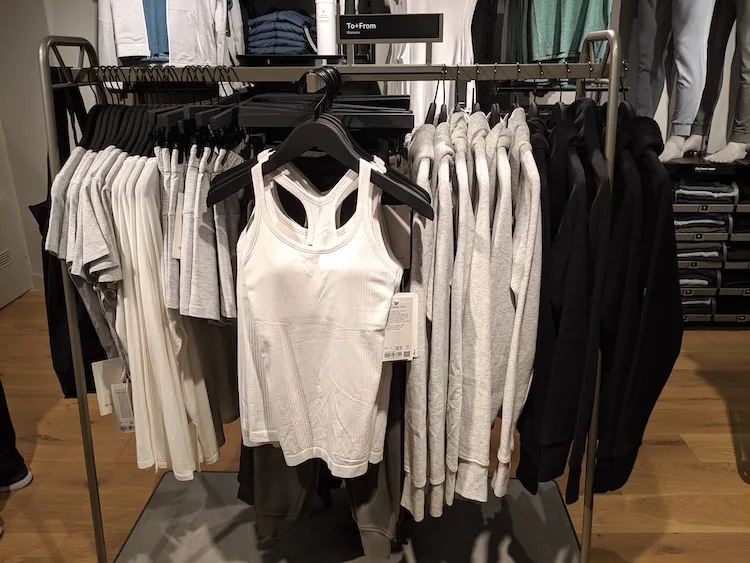At a yoga class, founder Chip Wilson noticed that the women around him wore ill-fitting cotton clothing that was not conducive to a yoga practice at all. Wilson took his experience in the apparel industry and created lululemon in 1998 to outfit women in high-performance fabrics that would actually improve your yoga practice and experience.
Initially, lululemon sold clothes directly to yoga instructors and practitioners. Designs were adjusted based on consunmer feedback. In November 2000, the company had opened its first retail store in Vancouver and became an overnight success.
20 years later, the company is now approaching 400 stores worldwide and is even publicly traded (LULU).
lululemon is currently worth $29.97 billion. In the last quarter (Dec. 2019), their profits were up 23% with a revenue of $916 million.
Factors that Make lululemon Expensive
Here are the top reasons why lululemon apparel is expensive.
#1 Proprietary Fabrics
lululemon creates its own proprietary fabrics. This means that their fabrics are constructed specifically for their brand.
Their patented fabrics are often high performance with features that anyone would want in versatile activewear.
Their Align Pants are made from Nulu, a buttery soft fabric that offers a naked feel. Fast & Free Tights are made with Nulux, a highly durable and moisture-wicking fabric that is made for high-impact activities.
The fabric that shot the brand into notoriety is their Luon fabric. Luon is a nylon and lycra blended fabric that their popular styles such as Wunder Under Pants and Define Jackets are constructed from.
Related: lululemon Fabric Guide [CHEATSHEET]
#2 Cult-like Brand Recognition
lululemon has created a cult-like community comprised of consumers, brand ambassadors, and a strong and supportive employee culture.
lululemon approaches its retail business with aspirational philosophy and personal development. The company offers benefits to both employees and consumers that promote a culture of personal growth, self-empowerment, and physical health.
Consumers are invited to community and nationwide events that bring together the community and those who love lululemon.
Employees are referred to as Educators. Applicants are required to submit goal sheets along with resumes. Their interview process is also done in a round table style and allows potential applicants to bond with one another.
Their fitness instructor discount program is called Sweat Collective and embodies a community of fitness professionals who are passionate about lululemon and well-being. Sweat Collective members are given a generous discount to wear lululemon apparel while teaching and leading fitness programs.
lululemon’s manifesto clearly communicates all these values that resonate with those who want to lead healthy and happy lives.
If you’d like to connect with the lululemon community, check out their community events here.
#4 lululemon Keeps Discounting to a Minimum
lululemon recognizes that discounting can be a detriment to their brand image. Earlier in lululemon’s timeline, they rarely offered discounts.
The lack of discounts combined with their scarcity retail model, allowed lululemon to keep their prices high and products highly coveted. Consumers were willing to pay premium prices for lululemon apparel.
Nowadays, you’ll see lululemon offering discounts through their We Made Too Much (WMTM) sales section, at online and in-person warehouse sales, outlets and even during special shopping events such as their Black Friday and Boxing Day sales.
You’ll find less popular color, patterns and styles offered at reduced prices.
Related: How to Save Money on lululemon Clothing
#5 lululemon Keeps Their Apparel Exclusive
lululemon purchased directly from lululemon.com is always authentic. lululemon purposely chooses to make their line exclusive to prevent their products from being sold on clearance racks in department stores or in the off-price channel.
You can sometimes find lululemon apparel in yoga or fitness studios. The selection will often be slimmer and curated for the specific studio. Some studios may also screenprint logos onto the lululemon apparel they offer, such as SoulCycle or Barry’s Bootcamp.
If you see an online retailer selling discounted lululemon, you should be wary of the authenticity of their products. This includes products sold on reselling websites such as Mercari, Poshmark and eBay.
You can often spot fake lululemon products by details such as size dots, rip tags, product tags and odd or uneven stitching.
Related: How to Find Lululemon Size Dots and Markers
#6 lululemon Operates on a Scarcity Model
As we mentioned before, lululemon operates on a scarcity model. This means they release a limited quantity of product with each upload. An upload is when lululemon releases new or restocked merchandise on their website or in-store.
lululemon does this to testing product performance to see how quickly they sell. If an item is popular and sells out quickly, lululemon may produce more of that same product or release variants of the same silhouette.
Related: lululemon Glossary of Acronyms and Terms You Should Know
#7 lululemon Lab Experiments
lululemon Lab is lululemon’s high-end apparel line that is a blend between activewear and streetwear. lululemon lab products are currently offered for both men and women.
Initially, the lululemon Lab was a place where in-house designers could create and test products before mass producing them for retail sale.
Their lab line may often contain experimental releases and high-performance fabrics not typically used in their regular activewear line. This also causes lululemon Lab products to be significantly more expensive than their regular line.

lululemon Lab Shiwa Puff Jacket ($598)
#8 “Power of Three” Strategy for Growth
lululemon is strategic about their bottom line. As part of their culture, lululemon is always creating goals and benchmarks individually and as an organization.
Their Power of Three strategy includes growth in three areas for 2020:
- Product innovation
- Double the size of its men’s revenues by 2023.
- Continue expansion in the women’s and accessories businesses.
- Plan to grow existing and new lines supporting yoga, running and training.
- Continue its product collaborations.
- Expand its popular Office/Travel/Commute category
- Pursue new opportunities, such as selfcare.
- Omni guest experiences
- Double its digital revenues by 2023.
- Offer an integrated guest experience across channels which are intended to inspire, provoke and celebrate guests who live a healthy and mindful lifestyle across experiences such as events, dynamic new store formats, and its innovative membership program that fosters connections among guests.
- Market expansion
- Quadruple its international revenues by 2023.
- Expanding across China, as well as the APAC and EMEA regions.
Read more about the Power of Three strategy.
Is Buying lululemon Worth It?
Personally, we love wearing lululemon because of their timeless styles and proprietary fabrics. They’re definitely invested in product performance and outfitting men and women to be their best.
All these factors combined are the biggest reasons why consumers are willing to pay premium prices for lululemon. Whatever they’re doing, it is working and we wish them continued success in 2020!
Related: Where to Buy and Sell lululemon
Resources:
 Want to know more about lululemon?
Want to know more about lululemon?
We have an entire resource page dedicated to everything lululemon related. Please check it out!
If there are any other topics you’d like us to shed some light on, please let us know!
Thank you for visiting today! If you found this encouraging or informative, please connect with us on Instagram or TikTok. Sign up for our monthly newsletter for updates and more. We promise we won't spam you! Feel free to unsubscribe anytime. If you're a brand and want to work with us, please visit this page to get in touch.
Lululemon has manufacturers all over the world, but if you’re wondering where the popular clothing products are made, the answer is MOSTLY in Vietnam.
That’s not the entire story, though.
The Canadian company has built a massive athleisure and sportswear brand by leveraging a number of different advantages – including worldwide manufacturing.
So, where are Lululemon products actually made?
The 19 Countries Where Lululemon Is Made
As one of the top sportswear brands in the world, it’s not surprising that Lululemon relies on manufacturing facilities all over the planet.
According to the most recent data about their suppliers from Lululemon themselves, the company relies on 138 different facilities across 19 different countries.
Of these facilities, Lululemon defines 113 of them as “Top Tier”, which means they handle, “Final product manufacturing.”
Here’s how many of those Top Tier facilities are located in each country:
- Vietnam: 37 – 32.74%
- China: 18 – 15.93%
- Sri Lanka: 12 – 10.62%
- Cambodia: 10 – 8.85%
- Indonesia: 7 – 6.19%
- Taiwan: 5 – 4.42%
- Philippines: 4 – 3.54%
- USA: 4 – 3.54%
- Peru: 4 – 3.54%
- Bangladesh: 3 – 2.65%
- Thailand: 2 – 1.77%
- Turkey: 2 – 1.77%
- Columbia: 1 – 0.88%
- El Salvador: 1 – 0.88%
- Haiti: 1 – 0.88%
- Mexico: 1 – 0.88%
- Portugal: 1 – 0.88%
So, as we mentioned at the beginning, the majority of Lululemon products are manufactured in Vietnam with China in a distant second place.
That being said, it’s interesting to note that while Taiwan only makes up 4.42% of this list of manufacturers, this country is responsible for the popular Luon fabric that has been so instrumental to Lululemon’s success.
Taiwan is where Lululemon gets “Luon”, a type of fabric made from 86% nylon and 14% Lycra. This material has been so important to Lululemon’s success, that the company trademarked the fabric.
Luon doesn’t just help to wick moisture away during workouts. The preshrunk, stretchy nature of the material is why it was largely responsible for Lululemon’s conquering of the athleisure world more than a decade ago.
While the nylon is responsible for providing adequate coverage, it’s the Lycra that gives Lululemon leggings a reputation for never stretching out. So, while they may come with a hefty price tag, that’s partially because you won’t need to replace them anytime soon (if ever).
And that’s why many women call them the best leggings on the market.
As of March 2013, Lululemon’s list of manufacturers still includes Eclat Textile Co. in Taiwan, as a Tier 2 facility – the original supplier for Luon, so don’t expect this country to lose its prominent role in the supply chain any time soon.
Lululemon’s Supply Chain Earns Top Marks
Being a worldwide brand with a worldwide manufacturing process, Lululemon depends on a complex supply chain to facilitate the creation and sales of their leggings, hoodies, belt bags, and much more.
And yet, Lululemon has received surprisingly impressive ratings for the way in which it sources the materials it requires to create these products.
Back in 2018, KnowTheChain commended Lululemon for how far it had come in improving its supply chain practices in just two years. The brand came in 2nd of the 43 companies that were analyzed for this category, including a 100/100 score for its “Purchasing Practices.”
By 2021, Lululemonmovedinto the 1st position.
Lulelemon has also gone out of its way to make formal statements against “modern slavery and human trafficking” in supply chains – issues that have haunted worldwide manufacturing practices.
This dovetails with the company’s Impact Agenda, which follows three pillars: “Be Human, Be Well, and Be Planet.”
And according to Ethos, Lululemon is actively pursuing these goals. They gave the company an “A” for “Overall Impact”, which put them in the top spot when compared to “industry peers” like Nike, Under Armour, and 15 others.
So, while Lululemon continues to grow its manufacturing footprint and supply chains, it’s clear they’re doing so with ethics in mind.
Lululemon’s Supply Chain Conduct Policies and Practices
You can also review the company’s Responsible Supply Chain Disclosure from 2022 for yourself to see the step Lululemon has taken to pursue the goal of ethical sourcing and manufacturing.
Amongst other things, the document lays out the “policies that govern [their] approach to responsible business conduct”, which includes their policies on:
- Global Code of Business Conduct and Ethics
- Vendor Code of Ethics
- Vendor Code of Ethics Compliance Benchmarks
- Foreign Migrant Worker Standard
- Supplier Agreement
- Certificate of Acknowledgement and Approval
They also outline their “New Vendor Approval Process”, which outlines:
- Prescreening
- Supplier Self-Assessment
- Responsible and Supply Chain Assessment
- Reassessment
- Engagement and Onboarding
- Ongoing Monitoring and Assessment
In 2022, the company carried out 452 assessments.
And again, you can review the details of these practices and their results in more detail by clicking on that link above.
Looking forward, Lululemon has announced that they are dedicated to a more diverse supply chain in the future by increasing the number of vendors they use that are owned and operated by women, as well as other underrepresented groups.
Does Lululemon’s Manufacturing Processes Add to Their Products’ Prices?
No.
If anything, this type of outsourcing – especially to Southeast Asia – traditionally helps companies keep their prices low.
But as you may already know, Lululemon products tend to be expensive.
That link will take you to a page that goes into more detail about why Lululemon charges what they do, but the short answer is simple: they can!
As we covered earlier, Lululemon makes incredibly high-quality products that are perfect as day-to-day athleisurewear, loungewear, or workout gear. One look at their unique manufacturing process will go a long way toward explaining why their products have become so well known for both their comfort and durability.
But Lululemon has also done an amazing job of marketing its range of clothes. Their innovative “community-focused” marketing strategy entails everything from traditional content creation to brand ambassador programs to in-store events.
This approach is so powerful that Lululemon’s brand value actually GREW during the pandemic. And not by some small percentage. It increased by a whopping 40%!
So, Then Why Is Lululemon So Popular?
Lululemon’s MASSIVE popularity stems from a combination of factors that have solidified its reputation in the athletic apparel market.
Despite the brand’s higher price range, its popularity continues to soar due to the exceptional quality and fit of its garments. Lululemon’s leggings, in particular, have garnered significant acclaim. The leggings embrace the body flawlessly, providing a flattering look without any discomfort. The premium materials used ensure their longevity, surpassing many competitors in terms of durability.
And, as we just covered, a big part of creating these high-quality products means sourcing the materials from dozens of different locations all across the globe.
Among Lululemon’s renowned leggings are the Align high-rise pants, known for their exceptional softness and stretchability. These pants come in various patterns, sizes, and colors, catering to different preferences.
The Align high-rise crops have also become extremely popular among customers. For running enthusiasts, the Base Pace high-rise fleece running tights offer a water-resilient material, making them ideal for colder weather conditions.
As a whole, Lululemon’s unwavering brand reputation can be attributed to the sense of community it has fostered among its customers.
Lululemon has successfully tapped into the ongoing demand for activewear, especially during the pandemic when many people sought comfortable and versatile clothing options while working from home. Athleisure not only provides comfort but also a professional appearance, making it a win-win solution for both work and workouts.
Who Owns Lululemon?
So far, we’ve gone through all the details behind how Lululemon products are made – from who manufactures them to where this manufacturing happens.
But many people ask this question because they really want to know who actually owns Lululemon, so let’s dive into that question.
Technically, Lululemon isn’t owned by anyone. Lululemon Athletica Inc. is now a publicly-traded company
But originally, Lululemon was founded by Chip Wilson, who served as the original CEO. Wilson – who was born in California but raised in Calgary – had a background in the sports industry.
After other ventures, he founded Wilson in 1998 with the aim of creating high-quality and fashionable yoga clothing.
The company initially operated out of a design studio that transformed into a yoga studio at night to cover the rent. Wilson relied on feedback from yoga instructors who wore his products, contributing to the early success of the brand. Lululemon’s first product was a pair of yoga pants made from nylon and Lycra that provided comfort and stretchability.
As Lululemon gained popularity, it expanded its product range and opened its first official store in Vancouver in 2000. Over the years, the company introduced innovative fabrics such as Luon, Luxtreme, Nulux, and Silverescent – something that was possible as Lululemon expanded its manufacturing process across dozens of different countries.
In 2007, Lululemon went public, with shares offered to the public, and raised significant capital. Wilson stepped down as CEO in 2008, and Christine Day assumed the position.
The Future of Lululemon’s Manufacturing Locations and Supply Chains
You don’t become a household name in a super-competitive industry without nailing every detail of your operation, from supply sourcing to product design to marketing to sales.
Lululemon has definitely done this.
And while they seem to have been especially masterful in their approach to worldwide manufacturing processes, it’s probably safe to assume that these practices will continue to evolve in the future. Lululemon is always looking for new opportunities to improve their products – and, of course, the bottom line.
Hopefully, they will continue to do this with their ongoing commitment to humane, equitable practices.



